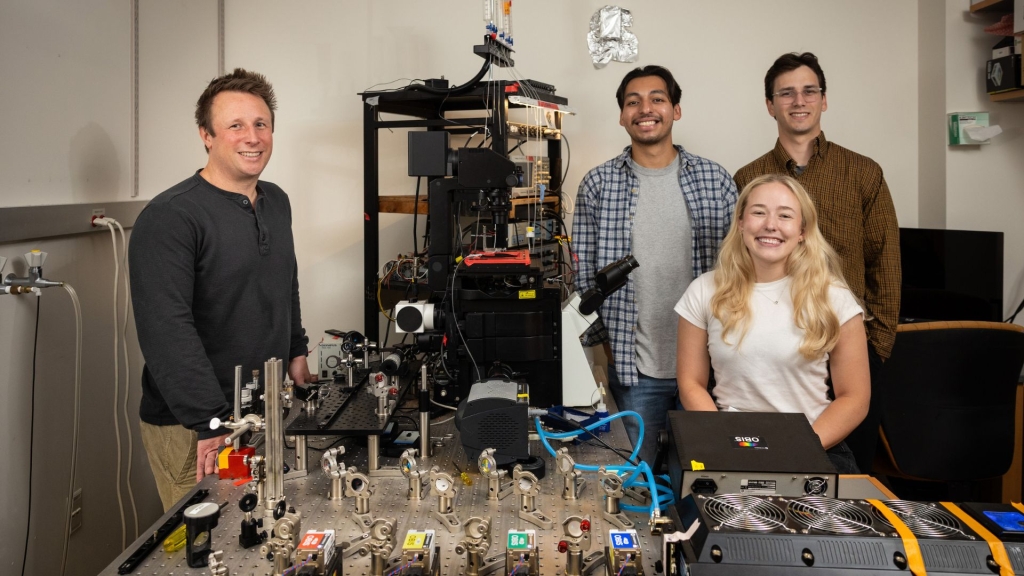The W.M. Keck Foundation has awarded Associate Professor of Biological Sciences Michael Hoppa a $1 million grant to develop groundbreaking neural imaging technology.
Known as fluorescence-lifetime imaging microscopy or FLIM, the technology will enable scientists to measure electrical activity in neurons, even when they’re not actively firing—a capability that was previously out of reach.
“By enabling us to measure membrane voltage with millivolt precision, this technology has the potential to revolutionize our understanding of the coding properties of neurons,” Hoppa says.
“I am so delighted at the splendid news of Professor Hoppa's success as a recipient of the highly prestigious Keck Foundation Award,” says Jane Lipson, associate dean for the sciences. “His innovative and ambitious research highlights the critical role of fundamental science in understanding biological processes, and also showcases Dartmouth’s ability to attract and sustain visionary leaders in the sciences.”
Hoppa is co-leading the three-year project in collaboration with assistant professor Ahmed Abdelfattah of Brown University.
When neurons fire, it’s typically considered an “all-or-none” response, akin to the binary code used by computers. Neurons activate when their voltage reaches a certain threshold; below that threshold, they remain in a resting state. But according to Hoppa, this is an oversimplification, because our brains operate in both binary and analog modes simultaneously.
“Large amounts of processing occur at the subthreshold level in different parts of the neuron,” says Hoppa. “We believe that resolving these analog voltage signals will help us identify several new molecular mechanisms underlying learning and memory.”
In his work at Dartmouth, Hoppa has identified several genetic mutations in humans that seem to impact neuron voltage during the resting phase in between neural impulses. But current techniques cannot measure the absolute voltage within a cell; they can only measure changes in a cell’s relative voltage.
“Sub-threshold changes in membrane voltage are completely invisible to current imaging technology,” says Hoppa. “I've been devising strategies for a long time to find a way that we can make these measurements accurately, because that would allow us to really start understanding how these channels malfunction in disease.”
FLIM will help overcome this limitation. The method uses genetically encoded fluorescent molecules whose “lifetime”—the timing of light emission—is tied to the cell’s voltage. (In other words, when they fluoresce depends on the neuron’s electrical state.) By tracking patterns of fluorescent emission under a microscope, researchers can monitor how a cell’s voltage changes during both resting and active phases, and how voltage varies across different parts of the cell—for example, between the cell body, axon, and dendrites.
Hoppa and Abdelfattah have already begun designing a toolkit of fluorescent molecules and have built a prototype microscope to test the technique. The three-year Keck funding will give them the time and support to refine their system.
“We plan to test FLIM first at a single cell level, and from there we're hoping to scale this up to record several hundred neurons at one time in a living animal like a mouse,” says Hoppa. “One of the first things I want to investigate is how resting voltage is related to the amount of neurotransmitters released.”
Ultimately, Hoppa hopes that FLIM will be adopted by other researchers to advance neuroscience and help develop treatments for neurological disorders such as epilepsy and Alzheimer’s disease.
“We think this tool and method are going to break open voltage imaging to the wider scientific community,” says Hoppa. “Beyond neurobiology, this approach has applications in other biological processes where voltage plays a role, such as insulin secretion in the pancreas and possibly even the formation of bacterial biofilms.”
He says that he feels fortunate to be part of the Department of Biological Sciences, with colleagues tackling questions across living systems. “I’m excited to collaborate to better understand a lot of different biological processes beyond the brain.”
The W. M. Keck Foundation was established in 1954 in Los Angeles by William Myron Keck, founder of the Superior Oil Company. One of the nation’s largest philanthropic organizations, the foundation supports outstanding science, engineering, and medical research; undergraduate education; and arts and culture, education, health, and community service projects in southern California.
